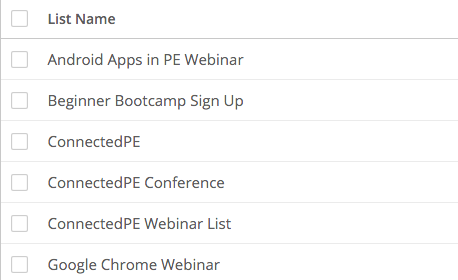If you have an email list then you will understand the power of being able to communicate to people that want to hear from you. However, as your audience grows you soon realise that not every email you send is applicable to every person. With this in mind, the more you can learn about the audience, the better you can segment them and deliver timely and relevant information.
This can be done via two methods
Email List Segmentation
Rather than having one email list, you can very easily setup and create multiple email lists based on interests. See below.

In the above case, each contact can be added to the lists that are most applicable to the content they opted into receive. This ultimately means that when you send a campaign, it is likely to be received by only those people who are likely to find it useful.
Tagging Your Contacts
While email lists are great for groups of people you repeatedly want to email, some email autoresponders allow you to add tags. This allows you to store additional information about your contacts so you can send to an even more targeted emails.
Tags can include literally anything you choose and can be added to a contacts record through automation rules that add them based on actions taken in your emails. Over time this grows into a mass of useful information that can be used to send more useful information to people.
In my online business, my tags tend to focus on the types of content people have opened and engaged with. This enables me to get back in touch with them again when new content from that type arrives. In the example below, I could easily communicate directly with all people who downloaded a specific infographic. This could be very useful when a new infographic arrives.

Further to this, I also tag contacts by country. This lets me drill down on contacts who have an interest in specific content and reside in a certain location. Because of this next level tagging and segmentation, I’m regularly able to secure paid workshop work in countries all over the globe automatically.
Here’s How I Use Tags & Segmentation
During the last few months of my recent world tour, I was keen to find some finish the trip in Europe somewhere. Knowing that my tags and segmentation were setup and running well, I was able to do the following.
1. Open Active Campaign and look for email addresses & tags in my audience from European Countries that I have never ran a workshop in. In this case I searched for ‘Poland’, ‘Hungary’ & ‘France’.
2. Based on the tags I located a list of candidates and sorted them by engagement.
3. To do this I setup a scoring system in active campaign to measure engagement in opens/clicks/etc. The people with the highest scores are those whom are likely to be the most responsive to my questions and emails
4. I then sent an email to the list of candidates with the headline “Workshop @ Your School?” – in the email I outlined that I was in the region, and available for private workshops in November before returning to Australia.
5. The email was sent with Gmail, where I use the Sidekick Chrome Plugin to track opens of each email.
6. Within a few days, I had received a very interested response from a school in Hungary who were asking for costings etc.
7. Responded outlining the per day fee which they accepted
8. Invoiced them and added Hungary as a stop on my way back to Australia. As this is a private event, there is no promotion, costing or anything needed to fill the workshop. Simply turn up and run the event.
9. Celebrate a nice win & repeat it for a new location
For me this is why segmenting and tagging your contacts is 100% worth the time and effort to setup. It enables you to contact the right person and the right time, with the right message. Anything less than this is simply not good enough.
